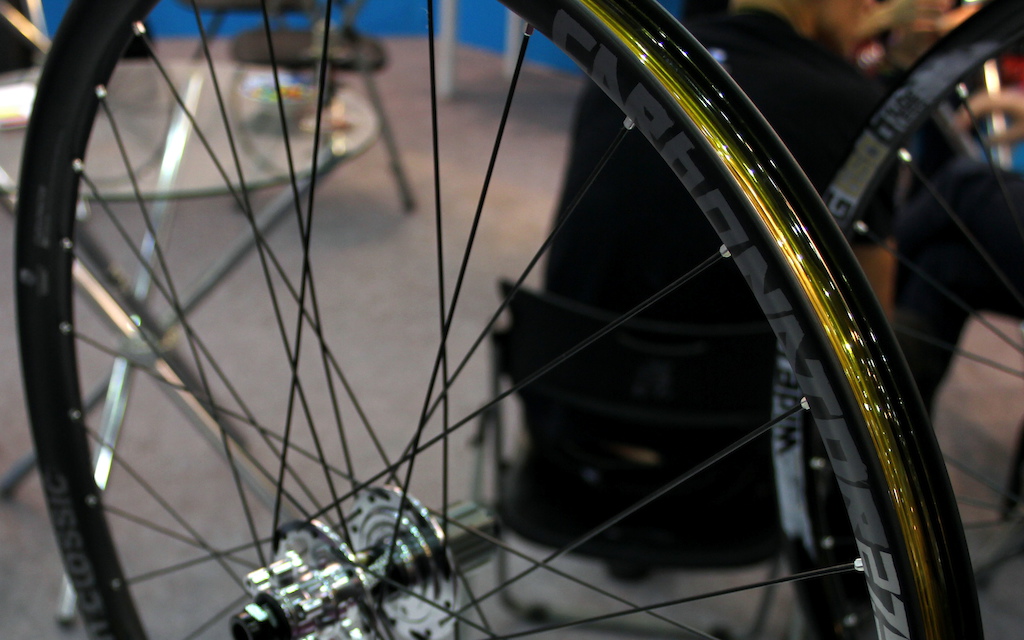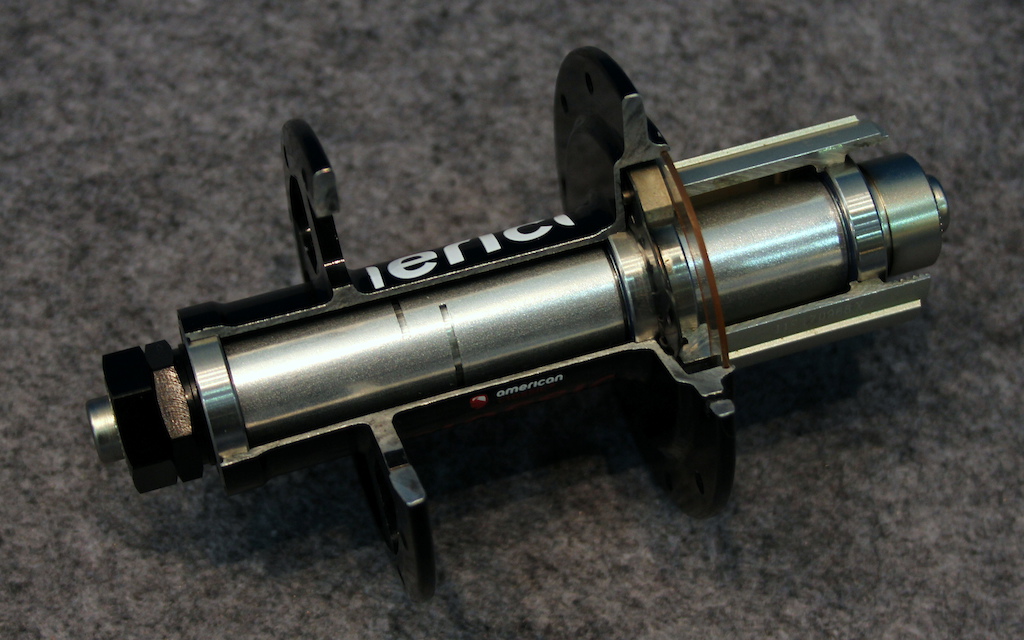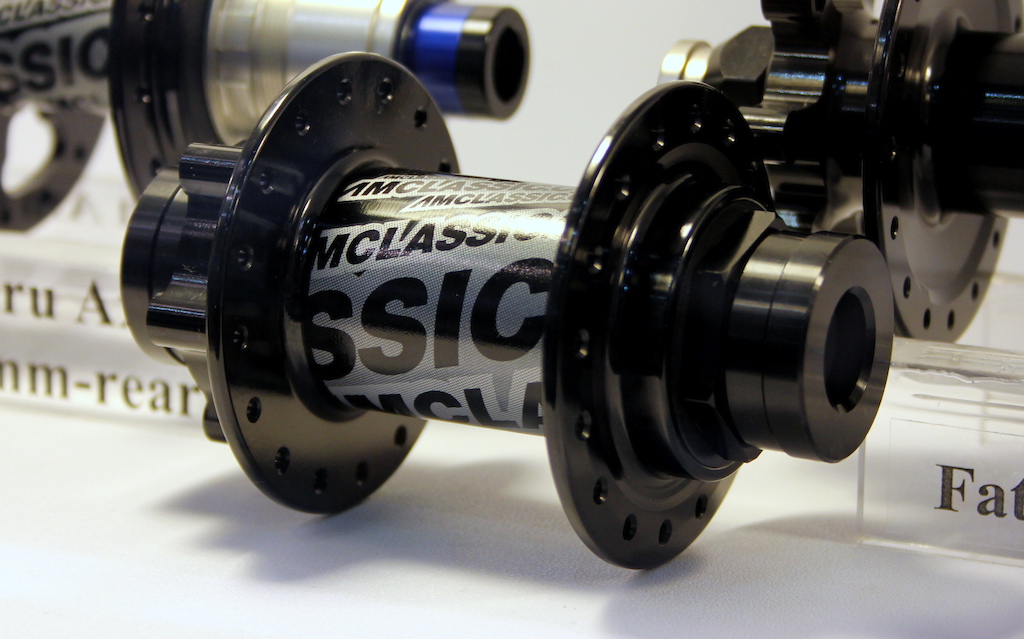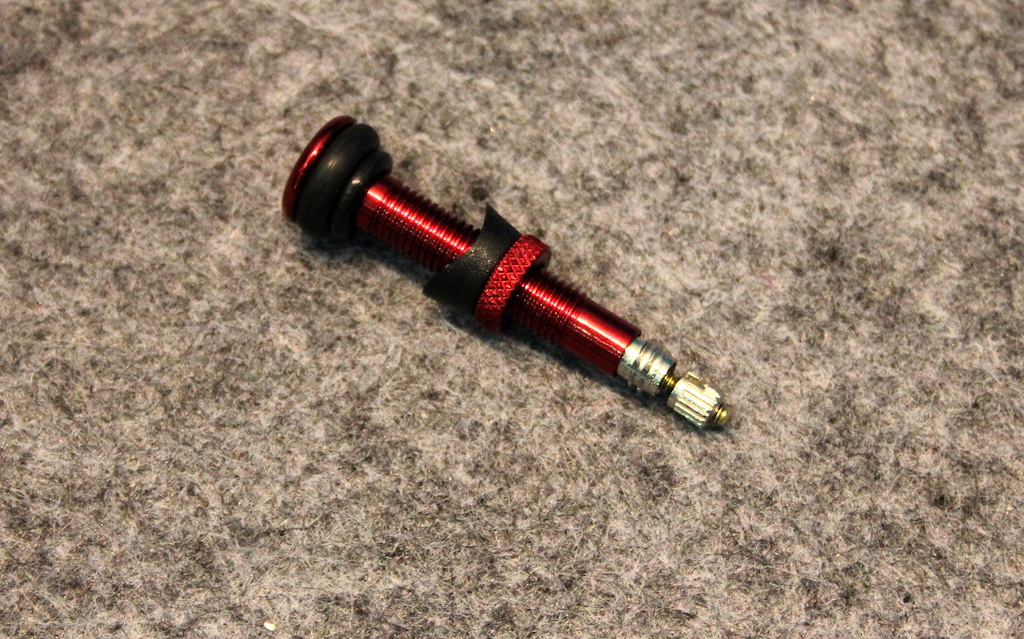American Classic - Taipei Show 2015
American Classic
American Classic owner Bill Shook says that, apart from some dings, they have never had of one of their Wide Lightning rims fail. Despite this, he was still determined to better his design and created this Carbonator wheelset. The carbon rim comes with a fifteen gram weight penalty over its alloy brethren, but Bill wanted to over-build in order to improve upon the performance and reliability of the Wide Lightning. The new rim has a 26mm internal width and a hookless rim wall that measures 3mm thick, while the bead seat slopes downwards from the centre of the rim to help with burp security - the bead will actually tighten as it is pushed or pulled inwards.
The hubs have a number of interesting features and a trio of patents. First is the freehub body that has three steel inserts to prevent steel cassette carriers biting in to the softer alloy, which might not be a new idea but is a smart one. The second is the two cut outs through the sleeve that spaces the inner bearing races. This makes the sleeve behave like a leaf spring that will absorb pressure when preloading the bearings, giving them less rolling resistance, and it will self adjust as the bearings wear. Inside the freehub there are six pawls that are engaged using a patented timing plate rather than springs - the pawls only move when prompted to engage, which reduces rolling resistance. With standard springs and pawls they are constantly being pushed in to the ratchet teeth, and there is also a very small difference in the timing as each pawl engages, with the timing plate this happens at exactly the same time. Shook says that this creates the strongest system on the market.
The Carbonator wheelset weighs in at 1,595 grams (27.5") and costs $1,799 USD. All the usual options are available, and Boost hubs with a difference are on the way. Cecile and Cedric Ravanel will be out to prove this wheelset on the EWS circuit in 2015, riding for the newly formed Commencal/Vallnord Racing Team.
American Classic have taken a slightly different approach to other manufacturers jumping on the Boost bandwagon. While other brands simply moving front hub flanges outwards 5mm on each side, Shook have added extra 10mm of width to the non-drive side axle, and the flange width hasn't changed from their regular hubs.This makes for a symmetrical wheel build, which they say is more beneficial in terms of strength and weight than a wider base to the spoke triangle. A symmetrical wheel will have equal spoke tension rather than one side having a higher tension and therefore less pressure on the spokes and eyelets, and the possibility of building a slightly lighter rim. The same theory is applied to the rear hub which adds 6mm to the non-drive side between the flanges and disc mount, not quite achieving symmetry, but close.
Bill didn't seem to be a fan of the new Boost standard, and says he only produced these hubs to give his customers the option. He feels that the industry isn't thinking outside of the box, and suggests the main reason for Boost is to move the chain line further outboard, to give clearance for wider tyres and shorter chainstays, not to create wider hub and stronger wheel. He's a fan of Cannondale's F-Si cross-country race machine which uses an offset rear end to achieve the same effect. The F-Si has some of the shortest 29er chainstays on market with suitable rear wheel clearance and chain line. "We didn't need the Boost standard in this ever-changing industry, and could have simply used non-symmetrical rear ends to achieve the same results," he said.
Until now, the only options for RS-1 owners were SRAM and DT Swiss wheelsets. This hub has bigger axle and clamping area then competitors for even more stiffness. The sides of the axle are also smooth instead of serrated, and Shook says that with the design of the RS-1 the serrated edges can cause the bolt-thru axle to work itself loose as the 'teeth' dig in to the alloy fork dropout, which shouldn't be an issue with smooth sides.
This is an example of the valves that are supplied with all American Classic wheelsets. They use two different sized o-rings at the base of the valve, a configuration that means that the valve seal is created against the flat surface of the rim instead of sealing against the edge of the valve hole. This is said to provide more surface area to give a better seal that's less likely to break when adjusting the valve or using a pump.
Author Info:
Must Read This Week
Sign Up for the Pinkbike Newsletter - All the Biggest, Most Interesting Stories in your Inbox
PB Newsletter Signup


 The Carbonator was designed to out-perform the Wide Lightning wheelset.
The Carbonator was designed to out-perform the Wide Lightning wheelset.







 Member since Aug 23, 2009
Member since Aug 23, 2009
SRAM PM: Yes sir, the guys over at American Classic.
SRAM C-Level Guy: Who the fcuk is American Classic and how dare they mess with us?!
SRAM PM: They are relatively well known sir, smaller than DT Swiss, but not insignificant.
SRAM Engineer: Sir, they aren't exactly refusing to do “boost”. They just aren't moving the flanges out, but they are providing the same width hubs that will work in our “boost” forks.
SRAM PM: True, but the wider flanges are what we told marketing to position as the main reason for Boost, you know, for stiffer wheels.
SRAM C-Level Guy: Then get them on board, or make dame sure they get maligned in the press as yet another incompatible standard or for producing products with crippled retarded child slave labor or something. We need everyone on board so we can boost our profits. Now get the fcuk out of my office!
www.bike-forum.cz/upload/users_lib/100/fotogalerie/big/light-bicycle.jpg
I do believe wheels are a valuable aspect of a bike, but I think components like the suspension and frame carry more weight in the performance department.
I love my Velocity Blunt 35s but wish they had welded joints and a better bead design that didn't fold so easily.
RC feel free to chime in.
Hey boost... ...yeah you... > GTFO!
Erm.No?
The whole point of the sleeve between the bearings in most cartridge bearing hubs is that it doesn't compress.
If the hub uses angular contact bearings, then this sprung sleeve is unnecessary.
If the hub uses standard cartridge bearings then this sleeve will promote faster bearing failure.
I'm confused about the so called benefits of this design. Anyone care to explain?
Owner at American Classic should license to other manufacturers, they could pay royalties and he could sit on beach drinking cocktails after riding fatbike through the surf
Owned too many hubs with light weight alloy bodies (Hope the worst offender!) ruined by cassette gouging = clicking / creaking and under extreme examples, causing bad shifting as timing on individual cogs thrown out by rotation as they cut into the soft body.
Hope offer their hubs and Hoops wheels with aluminium alloy body as stock, you then have to pay to upgrade to the heavy steel body. The old Titanium alloy body on the Bulb was awesome, but became too expensive to manufacture so they stopped doing it when the Pro II hub was launched.
The steel body is crazy heavy, I know because after ruining 3 aluminium alloy bodies on my 10 speed road bike in 1 season, they finally moved me to steel, Hope were great with warranty support, but its not how a freehub body should behave.
ep1.pinkbike.org/p4pb10360053/p4pb10360053.jpg
It may not sound like much, but the weight of the replacement steel body was so much it basically made what had been a weight competitive / good value wheel set completely uncompetitive.
I had notching on several pairs of Hope MTB wheels whether used with SRAM PG-990 or Shimano XT cassettes, the small loose cogs always bite into the soft body over time.
Would be great to see Hope able to use the AC style method with small leading strips on the leading edges of the body, would solve all those wear problems!
"The carbon rim comes with a fifteen gram weight penalty over its alloy brethren, but Bill wanted to over-build in order to improve upon the performance and reliability of the Wide Lightning."
If you make both rims the exact same dimensions; width, thickness, diameter, etc. the carbon rim should be both stronger (much higher tensile strength and modulus of elasticity) and lighter (lower density). Add in the fact that this rim is (according to the article) narrower than the aluminum version (less material required) there should be no reason for it to be heavier, even if it is stronger. You should be able to gain both strength and decrease weight. But to make it stronger at the expense of weight could have been done with aluminum, and certainly not for a 2x price premium.
Well, for the front hub, it is completely reasonable. Going from a road bike 100mm width to a 110x15mm width increases the distance between the fork lowers, thus increasing tire clearance.
However, for the rear 148mm spacing makes no sense at all. I can understand the 142x12mm standard, being the mid point between 135mm and 150mm and that brings me to the point I am trying to make: WHY CAN'T WE JUST USE THE 150X12MM STANDARD? LIKE WHAT DIFFERENCE IS IT REALLY GOING TO MAKE IF THE HUB IS 2 MILIMETERS NARROWER???? What are we coming to?
This new 148 standard is a 141mm spacing with the alignment slots... Its a mildly pointless intermediate standard for people who cant align their wheels properly. But more pointless is the new 110x15mm front axle when you already had 20mm axles the same width for over a decade.
The laughing point of it all, is heaps of companies dont even increase flange spacing between 135 & 150mm hubs and the whole claimed reasoning for 'boost' is 'increased flange spacing'... Companies are just going to sell the new axle spacing without changing the flanges.... Lol
The engagement is not fantastic as others have mentioned but for trail or xc use it's fine, and I can't feel any engagement difference between the AC and hope (for sake of reference).
@Kark - the engagement is slower than something like a CK but it also does not drag like a CK when coasting. I'd rather maintain faster descending and coasting than have a quicker engagement in racing. Quick engagement has its place - trials, single speed, etc. or even just as a preference. I actually really enjoy it, however I wouldn't describe the AC hub as "not fantastic" but simply different and has its appropriate usage.
I actually like my AC hubs a lot. Nearly silent, no drag and super light while (in my experience) being quite durable. But, I don't completely discount others experiences either, and I trust that some of the internet criticism thats dumped on AC is warranted in some cases at least.
Next question?
Those American classics WL rims are only 26mm wide internally?
The alloy versions are 29.3 mm , it seems strange to me it would only be 26mm on the carbons.
26mm Isn't all that wide these days. Or does that big round hookless carbon lip provide some real estate
For the tire to use or ooze over, extending the functional internal width?
every pair of american classic wheels ive seen have them.
Also boo-hiss for no 26" wide lightning rim-only option.
But they ALL have dings in!